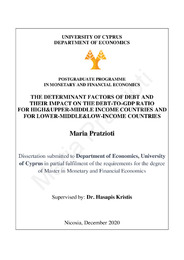The determinant factors of debt and their impact on the debt-to-gdp ratio for high&upper-middle income countries and for lower-middle&low-income countries

View/
Date
2020-12-27Author
Pratzioti, MariaPublisher
Πανεπιστήμιο Κύπρου, Σχολή Οικονομικών Επιστημών και Διοίκησης / University of Cyprus, Faculty of Economics and ManagementPlace of publication
CyprusGoogle Scholar check
Keyword(s):
Metadata
Show full item recordAbstract
In this study, an attempt is made to investigate the possible determinants of the debt-to-GDP ratio for two groups of countries? high-income countries and low-income countries. To be more specific, it is examined the existence of a causal relationship between the statistically significant determinants of debt, on the ratio of debt-to-GDP of an economy of a country. The database used to explore the existence of causality, is a panel data panel with data of 24 high-income (16) & upper-middle income (8) countries from 1970 to 2019, as well as the other half group of the database includes data for 18 lower-middle (11) & low (7) income countries from 1970 to 2019 too. Furthermore, the methods of estimation used are the Fixed Effects method, the Random Effects method and the method that makes a use of auxiliary variable. For the mitigation of the Endogeneity problem, 2SLS (Two-Stage Least Squares) Method is applied. In conclusion, based on the empirical analysis of this analysis, GDP growth rate is one of the main determinant factors of the debt-to GDP ratio.
